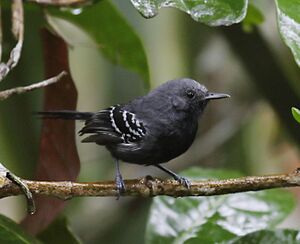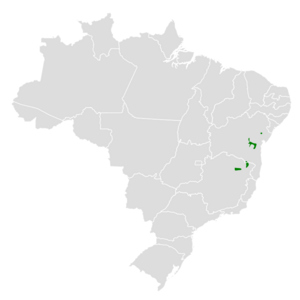Narrow-billed antwren facts for kids
Quick facts for kids Narrow-billed antwren |
|
|---|---|
 |
|
| Male at Boa Nova, Bahia State, Brazil | |
| Conservation status | |
| Scientific classification | |
| Genus: |
Formicivora
|
| Species: |
iheringi
|
 |
|
| Synonyms | |
|
Neorhopias iheringi |
|
The narrow-billed antwren (Formicivora iheringi) is a small bird found only in eastern Brazil. It's part of a bird family called "typical antbirds" (Thamnophilidae). This bird is special because it lives only in one area, making it an endemic species.
Contents
About the Narrow-billed Antwren
What Makes This Bird Unique?
The narrow-billed antwren is the only species in its specific group. Scientists don't think this antwren is closely related to other birds in its genus, Formicivora. In the past, some experts even thought it should have its own genus called Neorhopias. Recent studies have brought up this idea again.
How to Spot a Narrow-billed Antwren
This bird is about 11 to 12 centimeters (4.3 to 4.7 inches) long. One male weighed about 8.2 grams (0.29 ounces). Males and females look different, which is called being sexually dimorphic. They both have a somewhat long bill and tail.
- Males: Adult males are mostly dark gray. Their wings and tail are a darker blackish-gray. They have white tips on their wing feathers and outer tail feathers. The center of their throat and chest is black, their sides are white, and their undertail feathers have white bars.
- Females: Adult females have a pale stripe above their eye (a supercilium) and a whitish ring around their eye. Their upper body is olive-brown, with a grayer head. This olive-brown color turns reddish-yellow-brown on their upper tail feathers. Their wings are brown with light cinnamon edges on some feathers and reddish edges on their flight feathers. Their tail is reddish-brown. Their underside is mostly yellow-orange, almost white in the middle of their belly, and their sides have some white.
Where the Antwren Lives
Habitat and Location
The narrow-billed antwren lives in different areas far from the coast in eastern Brazil. You can find it in the states of Bahia and Minas Gerais. It prefers to live in the lower and middle parts of deciduous forests. These are forests where trees lose their leaves every year.
In some parts of Bahia, it also lives in a special type of forest called mata-de-cipó. This forest has an open lower area, with a few very tall trees and many dense trees in the middle. This bird can be found at elevations between 250 and 1,100 meters (820 and 3,600 feet) above sea level.
Antwren Behavior
Daily Movements
Scientists believe the narrow-billed antwren stays in the same area all year round. It does not migrate.
What They Eat
We don't know all the details about what the narrow-billed antwren eats. However, its diet includes insects and likely spiders. This bird usually looks for food alone, in pairs, or with its family. Sometimes, it joins groups of different bird species that are feeding together.
It typically forages between 1.5 and 8 meters (5 and 26 feet) off the ground. Sometimes it looks for food on the ground or as high as 12 meters (39 feet) up. It moves actively but carefully, picking at stems and branches in tangled vines. It also picks prey from live leaves, dead leaf clumps, and moss while perched. Sometimes, it flies out from a perch to catch moths in the air.
Reproduction and Family Life
The breeding season for the narrow-billed antwren is not fully known. It seems to happen between October and December, which is the wet season in that area. Not much else is known about how they raise their young.
Antwren Sounds
The song of the narrow-billed antwren is a series of very high, loud "tiúw" notes. It sings about two notes per second for about eight seconds. Its calls include short, sudden notes, often in pairs or threes, and a short rattling sound.
Conservation Status
Protecting the Narrow-billed Antwren
The IUCN (International Union for Conservation of Nature) keeps track of how endangered species are. They first listed the narrow-billed antwren as Threatened in 1988. Then it was changed to Vulnerable in 1994, and Near Threatened in 2004. Since 2023, it has been listed as being of Least Concern.
Even though it has a large overall range, it only lives in small areas within that range. We don't know the exact number of these birds, but their population is thought to be decreasing. Their homes are being cleared for cattle farms in central-south Bahia. Also, much of the forest in north-east Minas Gerais and nearby south Bahia has been cut down for coffee farms.
However, this bird seems to be able to survive even when forests are broken up into smaller pieces. It can live in small areas of forest. It is considered uncommon to fairly common. This bird does not live in any protected areas. But there are still good habitats with healthy populations of this species in the Jequié-Boa Nova region (Bahia) and at Almenara in Jequitinonha Valley (Minas Gerais). These areas are not officially protected, though.


